
The Book of Tobit, also known as the Book of Tobias or the Book of Tobi, is a 3rd or early 2nd century BC Jewish work describing how God tests the faithful, responds to prayers, and protects the covenant community. It tells the story of two Israelite families, that of the blind Tobit in Nineveh and of the abandoned Sarah in Ecbatana. Tobit's son Tobias is sent to retrieve ten silver talents that Tobit once left in Rages, a town in Media; guided and aided by the angel Raphael he arrives in Ecbatana, where he meets Sarah. A demon named Asmodeus has fallen in love with her and kills anyone she intends to marry, but with the aid of Raphael the demon is exorcised and Tobias and Sarah marry, after which they return to Nineveh where Tobit is cured of his blindness.
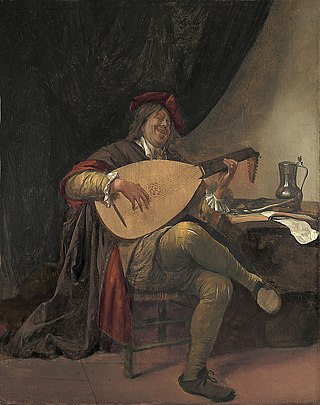
Jan Havickszoon Steen was a Dutch Golden Age painter, one of the leading genre painters of the 17th century. His works are known for their psychological insight, sense of humour and abundance of colour.
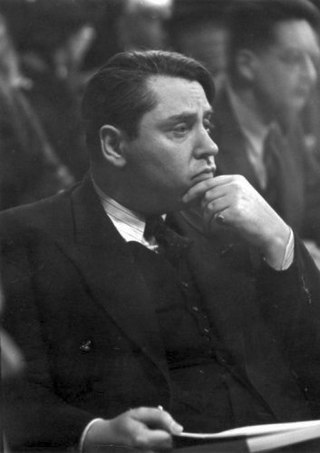
Jacques Goudstikker was a Jewish Dutch art dealer who fled the Netherlands when it was invaded by Nazi Germany during World War II, leaving three furnished properties and an extensive and significant art collection including over 1200 paintings, many of which had been previously catalogued as "Old Masters". The entire collection, which had been surveyed by Hermann Goering himself, was subsequently looted by the Nazis. Between the two World Wars, Jacques Goudstikker had been the most important Dutch dealer of Old Master paintings, according to Peter C. Sutton, executive director and CEO of the Bruce Museum of Arts and Science. Despite efforts of Goudstikker's widow after the war to regain possession of the collection, it was not until after her death that the Dutch government finally restituted 202 paintings to the Goudstikker family in 2006. To finance efforts to reclaim more of the stolen art, a large portion of them were sold at auction in 2007 for almost $10 million.

Nikolaus Knüpfer was a Dutch Golden Age painter.

Museum Bredius is a museum named after Abraham Bredius on the Lange Vijverberg in The Hague. It is remarkable for its collection of etchings and paintings, but is most attractive to visitors for its accurate restoration of the 18th-century Herenhuis interior with period furnishings.

Cornelis Hofstede de Groot, was a Dutch art collector, art historian and museum curator.

Dr. Abraham Bredius was a Dutch art collector, art historian, and museum curator.

Peeckelhaeringh, or Pekelharing, refers to an old Dutch word for pickled herring. Today it is best known as the name of a comic theatrical character who was the subject of a painting by Frans Hals.

Portrait of Cornelia Claesdr. Vooght is a painting by the Dutch Golden Age painter Frans Hals, painted in 1631 and now in the Frans Hals Museum. The painting is an oil on panel and is considered a pendant portrait to that of her husband, the Haarlem brewer and mayor Nicolaes Woutersz van der Meer.

Portrait of Sara Wolphaerts van Diemen is an oil-on-canvas painting by the Dutch Golden Age painter Frans Hals, painted around 1630–1633 and now in the Rijksmuseum, in Amsterdam. It is considered a pendant to the portrait of Sara's husband Nicolaes Hasselaer.

Portrait of Maria Pietersdochter Olycan is an oil-on-canvas painting by the Dutch Golden Age painter Frans Hals, painted in 1638, now in the São Paulo Museum of Art. It is considered a pendant to the portrait of Maria's husband Andries van Hoorn.

A Woman and Two Men in an Arbour (1657) is an oil-on-panel painting by the Dutch painter Pieter de Hooch; it is an example of Dutch Golden Age painting and is now in the Metropolitan Museum of Art, in New York.

Portrait of Jan Six is a 1654 oil-on-canvas painting by the Dutch painter Rembrandt van Rijn. Having been handed down many generations, via the direct descendants of the portrait's subject, Jan Six, the work remains in the Six Collection in Amsterdam.
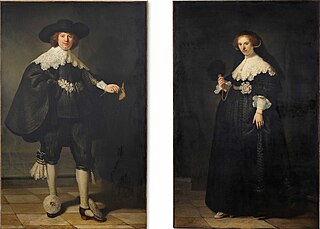
The pendant portraits of Marten Soolmans and Oopjen Coppit are a pair of full-length wedding portraits by Rembrandt. They were painted on the occasion of the marriage of Marten Soolmans and Oopjen Coppit in 1634. Formerly owned by the Rothschild family, they became jointly owned by the Louvre Museum and the Rijksmuseum in 2015 after both museums managed to contribute half of the purchase price of €160 million, a record for works by Rembrandt.

Portrait of Maria Trip (c.1639) is an oil painting on panel by the Dutch painter Rembrandt. It is an example of Dutch Golden Age painting and is now in the collection of the Rijksmuseum.
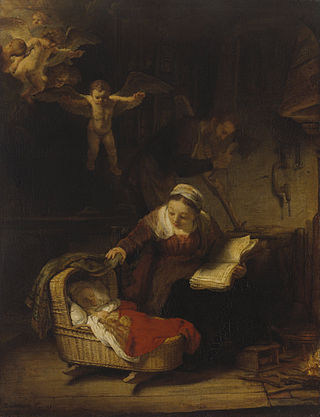
The Holy Family with Angels (1645) is an oil painting on canvas by the Dutch painter Rembrandt. It is an example of Dutch Golden Age painting and is now in the collection of the Hermitage Museum.

The Rape of Ganymede is an oil painting of 1635 by the Dutch Golden Age painter Rembrandt, depicting the myth of Ganymede. It is in the collection of the Gemäldegalerie Alte Meister in Dresden.

Tobias' Journey is an oil-on-panel painting by Flemish artist Joos de Momper. The painting showcases Momper's large scale, imaginary landscape painting and his interpretation of perspective in distant views while at the same time treating a biblical subject. The painting depicts the story of Tobit, a righteous Israelite of the tribe of Naphtali, living in Nineveh, who is sent to recover is father's money to Media, escorted by the Archangel Raphael. The painting is currently housed at the Rockox House in Antwerp.
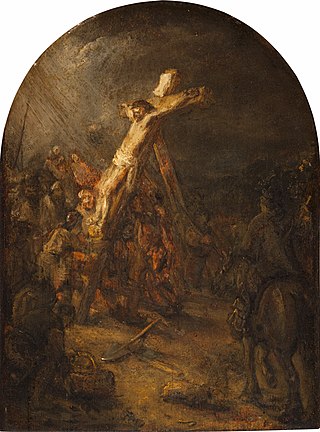
Raising of the Cross is a circa 1633-1645 painting by the Dutch Golden Age painter Rembrandt in the collection of the Museum Bredius. It was assumed to have been painted as a study for Rembrandt's larger painting of the same subject, as part of a series commissioned in 1633 by Frederick Henry, Prince of Orange. Having been rejected as autograph by the Rembrandt Research Project after Abraham Bredius's death, it was recently reattributed to the master by Jeroen Giltaij, though dendrochronology indicates the wood for the panel was not felled before 1642.
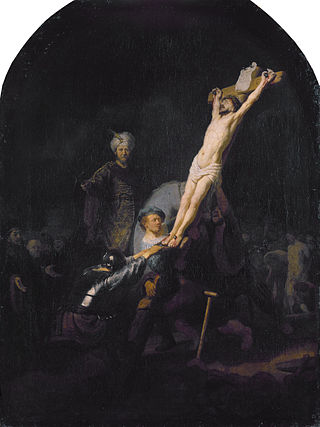
Raising of the Cross is a 1633 painting by the Dutch Golden Age painter Rembrandt in the collection of the Alte Pinakothek. It was painted as part of a "passion" series commissioned in 1633 by Frederick Henry, Prince of Orange. Together with its pendant, The Descent from the Cross, it is one of the rare paintings by Rembrandt with a continuous provenance from the date of completion to today.






















